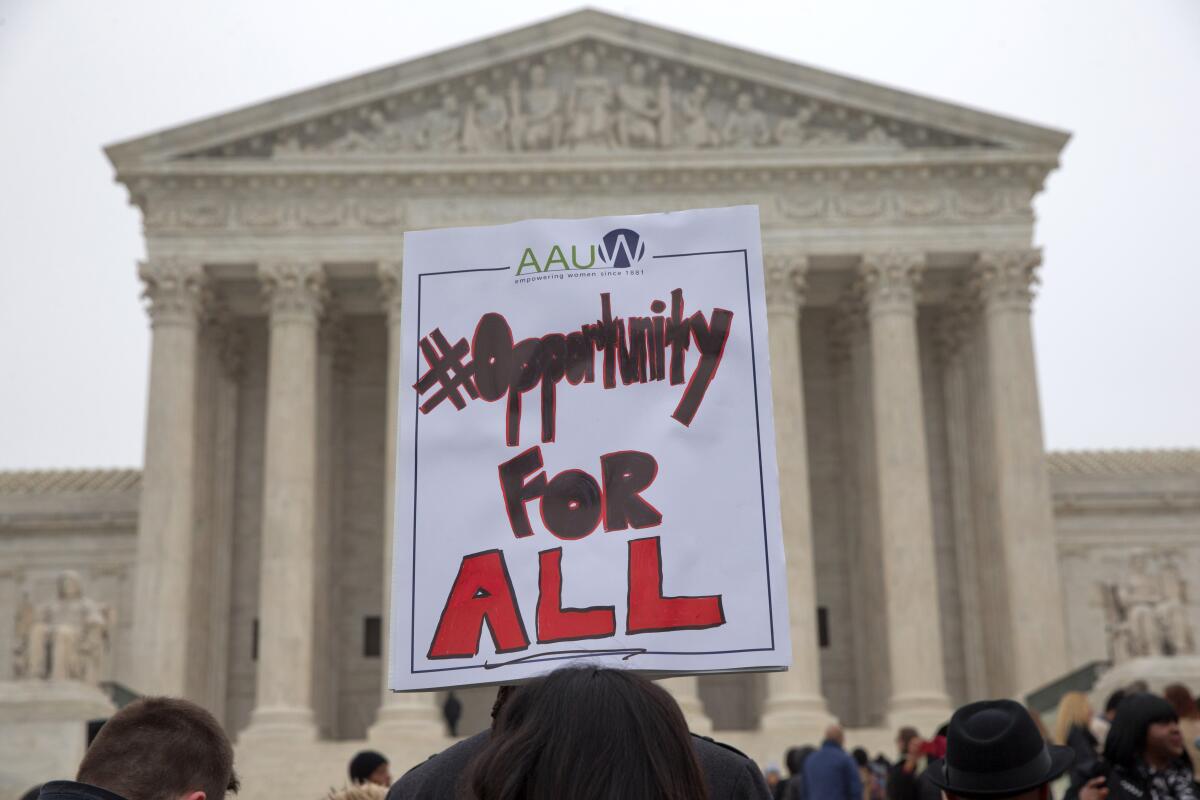Op-Ed: Why affirmative action bans hurt health equity

In 2015, the Assn. of American Medical Colleges published a startling statistic: Fewer Black men matriculated at medical school in 2014 (515) than in 1978 (542). These 515 Black men represented just 2.5% of all medical school matriculants in 2014.
Although more recent enrollment numbers indicate marginal improvement, Americans who identify as Black, Hispanic, American Indian, Alaskan Native, Native Hawaiian or from other Pacific Islander groups remain grossly underrepresented in medicine relative to their proportion in the U.S. population. To negate decades of exclusion for individuals from underrepresented racial groups, particularly Black Americans, one strategy public postsecondary schools have used to diversify their student bodies is affirmative action — considering race and ethnicity as one of many factors in admissions.
But several states, including California, Florida and Michigan, have banned the practice. The Supreme Court’s conservative majority is also poised this year to abandon years of precedent and strike down affirmative action. Our recent research shows that ending the use of affirmative action in medical schools would be catastrophic for the diversity of our physician workforce.
Bias leads to medical maltreatment of women and people of color, but a ‘group chat’ for doctors can help.
In our recent study in Annals of Internal Medicine, we found that for public medical schools in states that implemented affirmative action bans, enrollment of students from underrepresented racial and ethnic groups decreased by more than a third in the five years after the ban compared with the year before the ban. Meanwhile, a control group of schools in states that did not pass bans saw very little enrollment change for underrepresented students during the same period.
The decline in physicians from underrepresented groups should alarm all of us. The consequences not just for equity in economic and occupational opportunity, but also for people’s health, are substantial.
The COVID-19 pandemic has crystallized the poor quality of care racial and ethnic minority patients receive in the U.S., with the worst outcomes disproportionately hitting those groups. But even before the pandemic, it became increasingly clear that having more physicians from underrepresented groups can improve care.
For example, one 2019 study found that Black men randomly assigned to receive care from Black physicians were more likely to opt for every preventive service offered, such as cholesterol screenings — with implications for reducing Black men’s higher likelihood of dying from heart disease — compared with Black men who saw non-Black physicians. Research also suggests that on average, Black physicians spend more time with Black patients than white physicians do and that Black patients are more satisfied with their care when their physicians are Black. Similarly, a 2017 study of Spanish-speaking Latino patients with diabetes found that patients whose physicians spoke their language had much better control of their disease.
Patients do best when they are cared for by somebody more likely to understand their experiences. Prior studies have described medical distrust, stemming not only from abhorrent historical events like the Tuskegee study, during which government officials chose not to give Black men proper treatment for syphilis, but also from current interactions with the healthcare system. This mistrust discourages patients from fully accepting the recommendations of their physicians.
The American Academy of Pediatrics says it is examining all its guidance to eliminate ‘race-based’ medicine and resulting health disparities.
These are not absolute truths for every physician. But policies that reduce the number of physicians from underrepresented racial and ethnic groups — as we have found affirmative action bans to do at medical schools — will probably harm health outcomes of patients from those same groups.
So, how can we improve the diversity of the physician workforce and reap its attendant health benefits? First, at the policy level, we need to preserve the use of race-conscious admissions practices. This means reconsidering state bans on affirmative action where they exist (a 2020 attempt to reverse Califonia’s ban failed, but such efforts could benefit from a new political playbook). It also means understanding and conveying to relevant decision-makers the benefits of diversity to health, education and other areas, and identifying policies that harm this diversity.
Second, at the medical school level, admissions committees must commit to holistic review of applicants so that no single factor like standardized test scores rules out the consideration of an applicant. This will also require increased investment in interventions that minimize the influence of stereotypes that harm applicants. One such intervention would be an approach to implicit bias training that has actually been shown to work for admissions officers.
Third, we must strengthen the measurement and reporting of medical school racial and ethnic diversity and the consequences of not having such diversity. U.S. News & World Report released its first ranking of this kind in 2021, evaluating medical schools based on the percentage of enrolled students from underrepresented racial and ethnic groups. But instead of segregating such numbers into a separate ranking of “Most Diverse Medical Schools,” student body diversity should be directly incorporated into U.S. News’ more-viewed ranking of “Best Medical Schools.” Only then will medical schools be fully incentivized to address the racial and ethnic diversity of their students.
Seven decades ago, the Supreme Court ruled in Brown vs. Board of Education that racial segregation in public schools was unconstitutional. Today, the lives of our patients depend on diversity in our schools — and on affirmative action to get us there.
Utibe R. Essien is an assistant professor of medicine at the University of Pittsburgh School of Medicine. Dan P. Ly is an assistant professor of medicine at UCLA’s David Geffen School of Medicine. Anupam B. Jena is a professor of health care policy at Harvard Medical School and host of the podcast “Freakonomics, MD.”
More to Read
A cure for the common opinion
Get thought-provoking perspectives with our weekly newsletter.
You may occasionally receive promotional content from the Los Angeles Times.












